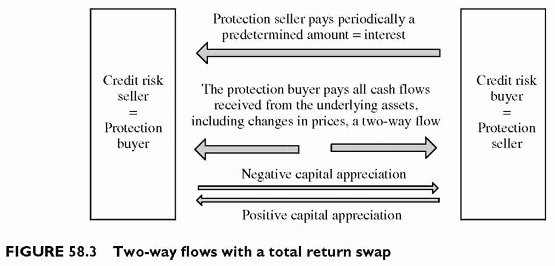TOTAL RETURN SWAP
Category: Risk Management in Banking
A total return swap exchanges the total return, current yield plus any change in value, whether positive or negative, between two assets. The exchange of cash flows occurs whether or not there is a default event. The swap exchanges flows and capital gains or losses periodically or at some fixed dates. Usually, periodic flows are interest payments and the capital gain or loss exchange occurs at a termination date. The seller of the total return swap is also the seller of the protection and the buyer of risk. The same terminology applies for the buyer of the swap, who is also the buyer of the protection and the seller of risk (Figure 58.3).
Total return swaps exchange returns, including any interest payment and capital appreciation or depreciation. The total return requires payment of a spread over LIBOR. The investor, or credit risk buyer, in the total return swap gains full exposure to the underlying asset. Should the risk materialize through a capital depreciation or a default, the buyer of the protection still receives the interest while the seller suffers a loss. The buyer of a total return swap always pays the seller the interest rate plus the agreed margin. The seller pays a total return to the buyer that can be positive or negative. If there is a capital appreciation, the risk seller pays the buyer. If there is a capital depreciation, the risk buyer pays the depreciation to the risk seller compensating the loss similarly to an insurance contract.

